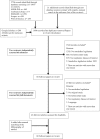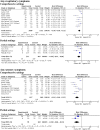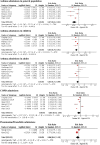Smokefree legislation effects on respiratory and sensory disorders: A systematic review and meta-analysis
- PMID: 28759596
- PMCID: PMC5536320
- DOI: 10.1371/journal.pone.0181035
Smokefree legislation effects on respiratory and sensory disorders: A systematic review and meta-analysis
Abstract
Aims: The aim of this systematic review and meta-analysis is to synthesize the available evidence in scientific papers of smokefree legislation effects on respiratory diseases and sensory and respiratory symptoms (cough, phlegm, red eyes, runny nose) among all populations.
Materials and methods: Systematic review and meta-analysis were carried out. A search between January 1995 and February 2015 was performed in PubMed, EMBASE, Cochrane Library, Scopus, Web of Science, and Google Scholar databases. Inclusion criteria were: 1) original scientific studies about smokefree legislation, 2) Data before and after legislation were collected, and 3) Impact on respiratory and sensory outcomes were assessed. Paired reviewers independently carried out the screening of titles and abstracts, data extraction from full-text articles, and methodological quality assessment.
Results: A total number of 1606 papers were identified. 50 papers were selected, 26 were related to symptoms (23 concerned workers). Most outcomes presented significant decreases in the percentage of people suffering from them, especially in locations with comprehensive measures and during the immediate post-ban period (within the first six months). Four (50%) of the papers concerning pulmonary function reported some significant improvement in expiratory parameters. Significant decreases were described in 13 of the 17 papers evaluating asthma hospital admissions, and there were fewer significant reductions in chronic obstructive pulmonary disease admissions (range 1-36%) than for asthma (5-31%). Six studies regarding different respiratory diseases showed discrepant results, and four papers about mortality reported significant declines in subgroups. Low bias risk was present in 23 (46%) of the studies.
Conclusions: Smokefree legislation appears to improve respiratory and sensory symptoms at short term in workers (the overall effect being greater in comprehensive smokefree legislation in sensory symptoms) and, to a lesser degree, rates of hospitalization for asthma.
Conflict of interest statement
Figures




References
-
- US Department of Health and Human Services (2006) The Health consequences of involuntary exposure to tobacco smoke: A report of the Surgeon General. Atlanta GA: US Department of Health and Human Services, Centers for Disease Control and Prevention, National Center for Chronic Disease Prevention and Health Promotion, Office on Smoking and Health; http://www.cdc.gov/tobacco/data_statistics/sgr/2006/.
-
- Framework Convention on Tobacco Control (FCTC). Prev Control. 2005;1:270–271.
-
- American Lung A. http://www.lungusa2.org/slati/smokefree_laws.php.webloc.
-
- American Non-smokers' Rights Foundation. Smokefree Status of Workplaces and Hospitality Venues Around the World. American Nonsmokers' Rights Foundation, 2011:1–9.
-
- European Commission. Green Paper—Towards a Europe free from tobacco smoke: policy options at EU level European Commission—Health & Consumer Protection Directorate-General; 2007.
Publication types
MeSH terms
LinkOut - more resources
Full Text Sources
Other Literature Sources
Medical

